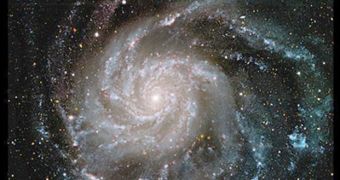Astronomers show in a new galactic map that the Milky Way may have arms that are straight rather than curved, which may give it a unique, square-looking appearance.
Determining the exact shape of the Milky Way is an extremely complex task, given that we cannot see it from the outside like we see for example our neighbor Andromeda.
When looking away from Earth through telescopes, very close stars are superimposed onto more distant ones, creating an optical illusion that requires a tremendous amount of effort to solve.
Without being able to determine the distances separating our galaxy's stars, it's hard to find out the shape of its arms, and therefore its overall appearance, Technology Review reports.
Another thing that makes studies harder is the current approach used to determine the structure of the galaxy, which is a two-step approach.
First, experts need to create a galactic model in which each individual component gets a simulations, to see how it moves in respect to Earth. All smaller simulations are then combined in the larger model.
The second step is finding cosmic clouds of ionized hydrogen, after which astronomers look at their emission spectra to determine the velocity that these structures have.
However, applying this method usually yields ambiguous results, and is also very prone to error, given that nobody has been able to determine how fast the Milky Way rotates.
Because of this, debates as of what shape our galaxy has have been raging on in the international scientific community for many years. The new study only adds more fuel to the fire.
The investigation was conducted by Brazilian researchers at the University of Sao Paulo, who were led by expert Jaques Lepine. Details were published in the online scientific journal arXiv.
Astronomers with this group replace analysis of ionized hydrogen with investigating clouds of carbon monosulphide gas, which are very common in the Milky Way.
They were able to obtain velocity data for about 870 regions in the galaxy, which enabled them to create a new galactic map.
Some of the arms were found to be straight, rather than curved, which most likely gives the Milky Way a squarish look when viewed from the outside.

 14 DAY TRIAL //
14 DAY TRIAL //